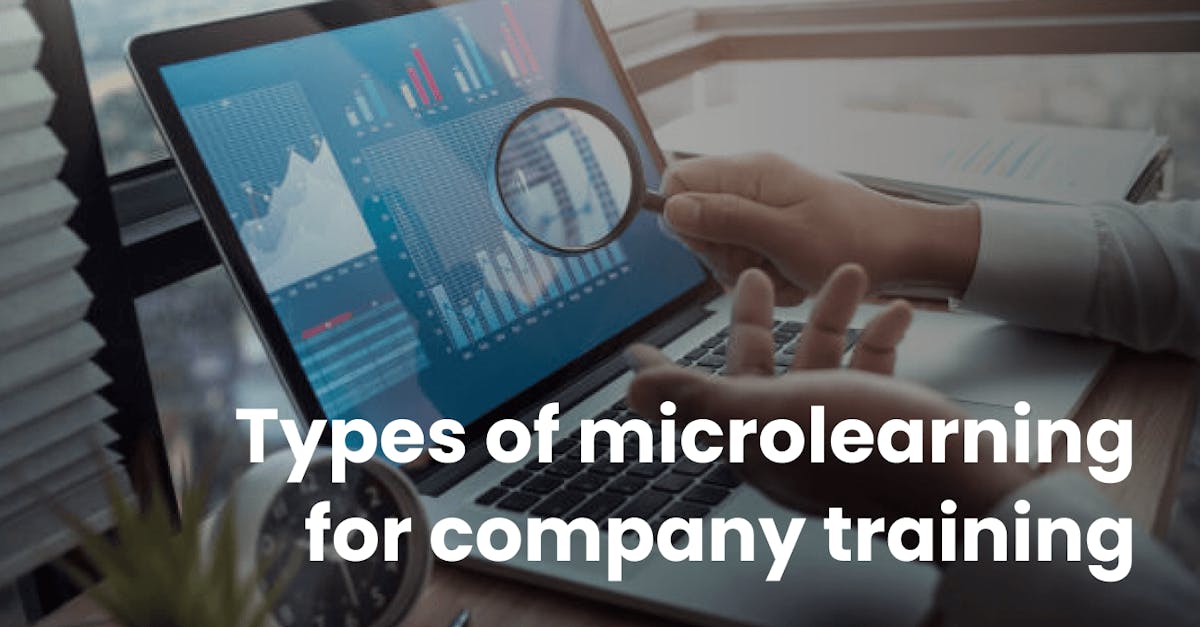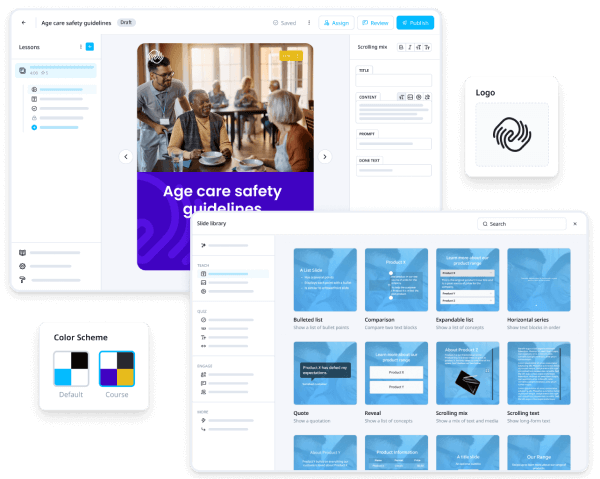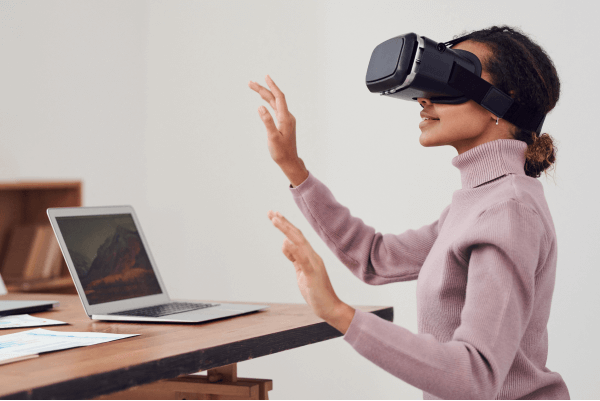10 Types of microlearning for company training

Supercharge your company's training programs and boost your team's skills in no time with microlearning. In this article, we'll walk you through fantastic types of microlearning that can revitalize your training efforts with great benefits for you and your team.
Gone are the days of marathon training sessions and information overload. Say hello to bite-sized, engaging, and effective learning experiences that fit right into your team's busy schedules.
Whether it's quick videos, interactive quizzes, or even a touch of gamification, we've got it all covered. With these microlearning types, your team will save time, stay engaged, and achieve your learning goals faster, without disrupting your workflow.
What is microlearning?
Microlearning is a learning method involving quick, bite-sized lessons that are both informative and impactful. Think of it as tiny, easily digestible nuggets of knowledge designed to help your team learn faster and remember better.
Instead of long, boring lectures, you can train your team with different types of microlearning. These short and engaging lessons will definitely fit into their busy lives, whether it's just watching a video, taking a quiz, or reading an article.
You can also personalize lessons based on the needs of each team member, helping them pick up new skills and information on the fly.
What are the benefits of microlearning?
Microlearning is your ticket to faster, more effective, and fun learning! Here are some awesome benefits of the various types of microlearning:
- Speedy Learning: Hours of snooze-worthy lectures are a thing of the past. Microlearning serves up quick, punchy lessons that are easy to grasp, so your team learns faster.
- Better Retention: Microlearning boosts retention because it's short and sweet, making it easier for the brain to remember.
- Fits Your Schedule: Your team members can sneak in a micro-lesson during a coffee break or while waiting in line. They won’t need to block out hours of their day training anymore.
- Increased Engagement: Interactive, snappy content keeps your team engaged. It's like learning without the yawns.
- Customized Learning: Your team can pick what they want to learn when they want to learn it. It's tailored to their needs.
- Confidence Booster: Quick wins in learning help to build confidence. With microlearning, your team will conquer new skills like a champ!
- Mobile-Friendly: Most microlearning lessons can be taken on one’s phone or tablet – it's super convenient.
Type of Microlearning # 1 - Microlessons
Microlessons are tiny, bite-sized lessons that serve up knowledge in a quick, focused, and incredibly effective way. Instead of overwhelming your team with lengthy training sessions, microlessons break down complex topics into easily digestible chunks.

The best part? Microlessons are flexible, so your team can access them whenever they need a boost, fitting perfectly into their busy schedules.
With microlessons, you're empowering your team to absorb information faster, remember it longer, and apply it with confidence, all while making the learning journey fun and enjoyable!
EdApp’s trusty microlessons are your ultimate ally in company training. These user-friendly lessons are a game-changer in keeping your team engaged with interactive content that’s easily accessible on any device.

With EdApp's creator tool, you can also customize lessons and courses based on your company's unique needs. Detailed reporting and analytics will also let you know exactly how your team is progressing. Plus, it's cost-effective and scalable, making quality training accessible for all.
EdApp is your ticket to a smarter, more agile workforce. Sign up today and foster a continuous learning culture that propels your company to success!
Type of Microlearning # 2 - One-Minute Videos
One-minute videos are short, snappy clips that deliver valuable insights and information in 60 seconds or less. This makes learning swift and captivating because no one has time for lengthy lectures anymore.

With one-minute videos designed for quick absorption, you're guaranteeing your team's engagement and retention. Plus, they're incredibly versatile, accessible on various devices, and ideal for on-the-go learning.
So, whether it's a quick tip, a product update, or a dose of inspiration, you can rely on one-minute videos to boost your company training needs. These will keep your team sharp, informed, and ready to conquer challenges!
Type of Microlearning # 3 - Podcasts
In the world of company training, podcasts are the friendly storytellers of microlearning. These audio gems deliver knowledge and insights in an engaging and portable format, perfect for employees on the move.
Whether it's a quick commute or a break between meetings, podcasts fit right into busy schedules, allowing your team to learn at their convenience.
With a wide range of topics and experts at your fingertips, podcasts offer a versatile way to keep your team informed, inspired, and up-to-date.
Type of Microlearning # 4 - Mini-Games and Interactive Quizzes
Mini-games and interactive quizzes turn learning into an exciting adventure, keeping your team engaged while they acquire new knowledge and skills. These microlearning trends are designed to be both fun and educational, offering immediate feedback and rewards that boost motivation.

Forget the boredom of traditional training – with mini-games and quizzes, your team can tackle real-life scenarios, test their understanding, and reinforce learning. All of these are in a format that feels more like play than work.
It's a win-win: they learn, they enjoy, and your company benefits from a team that's not just trained but excited to excel!
Type of Microlearning # 5 - Infographics and Flashcards
Like other microlearning examples, infographics present complex information in a visually appealing and easy-to-understand format. This makes it a breeze for your team to grasp key concepts at a glance.

Flashcards, on the other hand, are like pocket-sized study buddies, perfect for memorizing facts and terms. Both are highly effective tools that cater to different learning styles, making sure that everyone can access essential knowledge quickly.
Plus, their microlearning nature means that your team can squeeze in learning moments during downtime. This ultimately enhances their expertise and boosts their confidence – all while having a visual and interactive blast!
Type of Microlearning # 6 - Mobile Apps or Microlearning Platforms
Mobile apps and microlearning platforms offer a dedicated space where your team can access a treasure trove of microlearning content. These make lessons, videos, and quizzes available to them anytime and anywhere.

With the power of a smartphone or computer, your employees can choose what they want to learn and progress at their own pace. You can even create your own microlearning courses on these platforms.
With flexibility, convenience, and progress tracking, it's like having a 24/7 training partner who's always ready to help your team grow, adapt, and thrive in the ever-changing world of work!
Type of Microlearning # 7 - Email or SMS Courses
Email or SMS courses deliver quick and easy lessons right to your team's inboxes or mobile devices, making it easy for them to learn without leaving their email or messaging apps.

They're like a daily dose of knowledge and skill-building that your employees can consume at their own pace.
With regular reminders and the convenience of mobile learning, your team can stay on top of important topics and steadily expand their expertise. It's hassle-free, accessible, and guarantees that your workforce is continuously growing and ready to tackle new challenges with confidence!
Type of Microlearning # 8 - Microblogs
Microblogs generously give knowledge, tips, and insights that’ll foster a vibrant learning community within your organization. With microblogs, your team members can easily share their expertise, engage in discussions, and stay updated on industry trends.

Microblogs keep learning social, interactive, and accessible, helping your team stay connected and informed while effortlessly expanding their knowledge base.
So, think of microblogs as the friendly neighborhood of learning, where information flows freely and learning is as easy as scrolling through your favorite feed!
Type of Microlearning # 9 - Job Aids
Job aids are handy reference guides that have step-by-step instructions, quick tips, and essential information right when your team needs it most. They're the ultimate problem-solving companions, helping your team perform complex tasks with confidence and accuracy.

These aids reduce the need for extensive training, saving valuable time and resources, while empowering your team to excel in their roles and tackle challenges independently. It's like having an expert at your fingertips, ready to lend a helping hand whenever your team needs it.
Type of Microlearning # 10 - Virtual Reality (VR) and Augmented Reality (AR)
Virtual Reality (VR) and Augmented Reality (AR) create immersive, hands-on experiences that allow your team to dive into simulated environments or interact with digital overlays in the real world. This makes learning feel like a thrilling adventure.

Whether it's practicing complex procedures, exploring virtual prototypes, or mastering new skills, VR and AR offer a safe and engaging space for your employees to learn by doing.
As microlearning tools, these technologies boost retention, enhance understanding, and ensure that your team gains practical expertise in a risk-free setting.
It's like stepping into a whole new dimension of learning, where knowledge truly comes to life and transforms your workforce into skilled, confident, and future-ready professionals! The best microlearning platforms often offer VR and AR features in their software.
Author
Donna Dane
Donna is an elearning content writer for EdApp, a mobile-based microlearning platform designed for today's digital training needs. When she's not writing web articles, she writes lines of code or songs or anything food-related.
